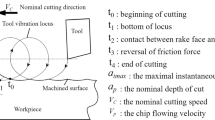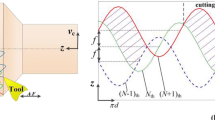Abstract
Ultrasonic vibration cutting (UVC) is an advanced machining method used to improve machining performance and surface quality in the manufacturing industry. However, the separation characteristic disappears when the cutting speed exceeds the maximum vibration speed, which limits its wide application in high-speed machining. Therefore, this study used the finite element method (FEM) to study the high-speed vibration cutting (HVC) processing performance of titanium alloys. High-speed vibration cutting is a precision machining method with a smaller cutting depth and feed rate, so it is necessary to consider the influence of the cutting edge radii on the cutting process. The cutting edge radii on high-speed vibration cutting and the impact of the traditional cutting process are discussed. The results show that the change in the minimum uncut chip thickness caused by changing the cutting edge radii during precision cutting has a significant influence on the experimental results. In addition, a simulation model was established, and comprehensive numerical analysis and comparison of high-speed vibration cutting, ultrasonic vibration cutting, and conventional cutting (CC) were performed to tool wear, cutting temperature, cutting force, and stress distribution. The simulation results indicate that the tool wear depth of traditional cutting during high-speed cutting is up to three times that of high-speed vibration cutting. High-speed vibration cutting weakens the influence of the cutting edge radii, but this new vibration cutting method did not significantly reduce the cutting temperature under dry cutting conditions.





















Similar content being viewed by others
Data availability
All data generated or analyzed during this study are included in this published article.
Code availability
Not applicable.
References
Zhu L, Ni C, Yang Z, Liu C (2019) Investigations of micro-textured surface gener-ation mechanism and tribological properties in ultrasonic vibration-assisted milling of Ti–6-Al–4V. Precis Eng 57:229–243. https://doi.org/10.1016/j.precisioneng.2019.04.010
Zheng K, Liao W, Dong Q, Sun L (2018) Friction and wear on titanium alloy surface machined by ultrasonic vibration-assisted milling. J Braz Soc Mech Sci Eng 40(9):1–12. https://doi.org/10.1007/s40430-018-1336-9
Ni C, Zhu L, Yang Z (2019) Comparative investigation of tool wear mechanism and corresponding machined surface characterization in feed-direction ultrasonic vibration assisted milling of Ti–6Al–4V from dynamic view. Wear 436:203006. https://doi.org/10.1016/j.wear.2019.203006
Tong J, Wei G, Zhao L, Wang X, Ma J (2018) Surface microstructure of titanium alloy thin-walled parts at ultrasonic vibration-assisted milling. Int J Adv Manuf Technol. https://doi.org/10.1007/s00170-018-3005-7
Zhang M, Zhang D, Geng D, Liu J, Shao Z, Jiang X (2020) Surface and sub-surface analysis of rotary ultrasonic elliptical end milling of Ti-6Al-4V. Mater Des 191:108658. https://doi.org/10.1016/j.matdes.2020.108658
Chen G, Ren C, Zou Y, Qin X, Lu L, Li S (2019) Mechanism for material removal in ultrasonic vibration helical milling of Ti6Al4V alloy. Int J Mach Tools Manuf 138:1–13. https://doi.org/10.1016/j.ijmachtools.2018.11.001
Xing Y, Deng J, Zhang G, Wu Z, Wu F (2017) Assessment in drilling of C/C-SiC composites using brazed diamond drills. J Manuf Process 26:31–43. https://doi.org/10.1016/j.jmapro.2017.01.006
Feng Y, Hsu FC, Lu YT, Lin YF, Lin CT, Lin CF, Lu YC, Liang SY (2020) Temperature prediction of ultrasonic vibration-assisted milling. Ultrasonics 108:106212. https://doi.org/10.1016/j.ultras.2020.106212
Feng Y, Hsu FC, Lu YT, Lin YF, Lin CT, Lin CF, Lu YC, Liang SY (2020) Tool wear rate prediction in ultrasonic vibration-assisted milling. Mach Sci Technol 24(5):758–780. https://doi.org/10.1080/10910344.2020.1752240
Wang J, Feng P, Zhang J, Guo P (2018) Reducing cutting force in rotary ultrasonic drilling of ceramic matrix composites with longitudinal-torsional coupled vibration. Manuf Lett 18:1–5. https://doi.org/10.1016/j.ijmachtools.2013.11.003
Yang Z, Zhu L, Ni C, Ning J (2019) Investigation of surface topography formation mechanism based on abrasive-workpiece contact rate model in tangential ultrasonic vibration-assisted CBN grinding of ZrO2 ceramics. Int J Mech Sci 155:66–82. https://doi.org/10.1016/j.ijmecsci.2019.02.031
Dong G, Lang C, Li C, Zhang L (2020) Formation mechanism and modelling of exit edge-chipping during ultrasonic vibration grinding of deep-small holes of microcrystall-ine-mica ceramics. Ceram Int 46(8):12458–12469. https://doi.org/10.1016/j.ceramint.2020.02.008
Yu T, Guo X, Wang Z, Xu P, Zhao J (2019) Effects of the ultrasonic vibration field on polishing process of nickel-based alloy Inconel718. J Mater Process Technol 273:116228. https://doi.org/10.1016/j.jmatprotec.2019.05.009
Wang Y, Lin B, Wang S, Cao X (2014) Study on the system matching of ultrasonic vibration assisted grinding for hard and brittle materials processing. Int J Mach Tools Manuf 77:66–73. https://doi.org/10.1016/j.ijmachtools.2013.11.003
Shen JY, Wang JQ, Jiang B, Xu XP (2015) Study on wear of diamond wheel in ultrasonic vibration-assisted grinding ceramic. Wear 332:788–793. https://doi.org/10.1016/j.wear.2015.02.047
Zhou W, Tang J, Chen H, Shao W (2019) A comprehensive investigation of surface generation and material removal characteristics in ultrasonic vibration assisted grinding. Int J Mech Sci 156:14–30. https://doi.org/10.1016/j.ijmecsci.2019.03.026
Feng Y, Hsu FC, Lu YT, Lin YF, Lin CT, Lin CF, Lu YC, Liang SY (2020) Surface roughness prediction in ultrasonic vibration-assisted milling. J Adv Mech Des Syst Manuf 14(4):JAMDSM0063–JAMDSM0063
Li C, Zhang F, Meng B, Liu L, Rao X (2017) Material removal mechanism and grinding force modelling of ultrasonic vibration assisted grinding for SiC ceramics. Ceram Int 43(3):2981–2993. https://doi.org/10.1016/j.ceramint.2016.11.066
Xiao X, Zheng K, Liao W, Meng H (2016) Study on cutting force model in ultrasonic vibration assisted side grinding of zirconia ceramics. Int J Mach Tools Manuf 104:58–67. https://doi.org/10.1016/j.ijmachtools.2016.01.004
Feng Y, Hsu FC, Lu YT, Lin YF, Lin CT, Lin CF, Lu YC, Liang SY (2020) Force prediction in ultrasonic vibration-assisted milling. Mach Sci Technol 25(2):307–330. https://doi.org/10.1080/10910344.2020.1815048
Nath C, Rahman M (2008) Effect of machining parameters in ultrasonic vibration cutting. Int J Mach Tools Manuf 48(9):965–974. https://doi.org/10.1016/j.ijmachtools.2008.01.013
Kong C, Wang D (2018) Numerical investigation of the performance of elliptical vibration cutting in machining of AISI 1045 steel. Int J Adv Manuf Technol 98(1):715–727. https://doi.org/10.1007/s00170-018-2277-2
Guo P, Ehmann KF (2013) An analysis of the surface generation mechanics of the elliptical vibration texturing process. Int J Mach Tools Manuf 64:85–95. https://doi.org/10.1016/j.ijmachtools.2012.08.003
Lotfi M, Sajjady SA, Amini S (2019) Wettability analysis of titanium alloy in 3D elliptical ultrasonic assisted turning. Int J Light Mater Manuf 2(3):235–240. https://doi.org/10.1016/j.ijlmm.2019.05.001
Tan R, Zhao X, Guo S, Zou X, He Y, Geng Y, Hu ZJ, Sun T (2020) Sustainable production of dry-ultra-precision machining of Ti–6Al–4V alloy using PCD tool under ultrasonic elliptical vibration-assisted cutting. J Clean Prod 248:119254. https://doi.org/10.1016/j.jclepro.2019.119254
Bai W, Sun R, Leopold J, Silberschmidt VV (2017) Microstructural evolution of Ti6Al4V in ultrasonically assisted cutting: numerical modelling and experimental analysis. Ultrasonics 78:70–82. https://doi.org/10.1016/j.ultras.2017.03.005
Tan DW, Guo WM, Wang HJ, Lin HT, Wang CY (2018) Cutting performance and wear mechanism of TiB2-B4C ceramic cutting tools in high speed turning of Ti6Al4V alloy. Ceram Int 44(13):15495–15502. https://doi.org/10.1016/j.ceramint.2018.05.209
Sui H, Zhang X, Zhang D, Jiang X, Wu R (2017) Feasibility study of high-speed ultrasonic vibration cutting titanium alloy. J Mater Process Technol 247:111–120. https://doi.org/10.1016/j.jmatprotec.2017.03.017
Mishra SK, Ghosh S, Aravindan S (2018) 3D finite element investigations on textured tools with different geometrical shapes for dry machining of titanium alloys. Int J Mech Sci 141:424–449. https://doi.org/10.1016/j.ijmecsci.2018.04.011
Yen YC, Söhner J, Lilly B, Altan T (2004) Estimation of tool wear in orthogonal cutting using the finite element analysis. J Mater Process Technol 146(1):82–91. https://doi.org/10.1016/S0924-0136(03)00847-1
Malakizadi A, Gruber H, Sadik I, Nyborg L (2016) An FEM-based approach for tool wear estimation in machining. Wear 368:10–24. https://doi.org/10.1016/j.wear.2016.08.007
Liu X, Zhang X, Wang D (2020) Numerical analysis of different cutting edge radii in hot micro-cutting of Inconel 718. Proc Inst Mech Eng C J Mech Eng Sci 234(1):196–210. https://doi.org/10.1007/s13369-020-05034-z
Lai X, Li H, Li C, Lin Z, Ni J (2008) Modelling and analysis of micro scale milling considering size effect, micro cutter edge radius and minimum chip thickness. Int J Mach Tools Manuf 48(1):1–14. https://doi.org/10.1016/j.ijmachtools.2007.08.011
Liu X, DeVor RE, Kapoor SG (2006) An analytical model for the prediction of minimum chip thickness in micromachining. J Manuf Sci Eng 128(2):474–481. https://doi.org/10.1115/1.2162905
Zhang X, Lu Z, Peng Z, Sui H, Zhang D (2018) Development of a tool-workpie-ce thermocouple system for comparative study of the cutting temperature when high-speed ultrasonic vibration cutting Ti-6Al-4V alloys with and without cutting fluids. Int J Adv Manuf Technol 96(1):237–246. https://doi.org/10.1007/s00170-018-1600-2
Funding
This work was supported by the National Natural Science Foundation of China (Grant Nos. 51205246, 51775328).
Author information
Authors and Affiliations
Contributions
Xu Zhang: investigation; writing—original draft; Yaotian Cheng: revision and proofreading of papers; supervision; Mingqiang Lv: experimental validation; Xuchao Miao: methodology; Chaoyu Xie: Data check.
Corresponding author
Ethics declarations
Ethics approval
The content studied in this article belongs to the field of metal processing, and does not involve humans and animals. This article strictly follows the accepted principles of ethical and professional conduct.
Consent to participate
Not applicable.
Consent for publication
Not applicable.
Conflict of interest
The authors declare no competing interests.
Additional information
Publisher's note
Springer Nature remains neutral with regard to jurisdictional claims in published maps and institutional affiliations.
Rights and permissions
Springer Nature or its licensor (e.g. a society or other partner) holds exclusive rights to this article under a publishing agreement with the author(s) or other rightsholder(s); author self-archiving of the accepted manuscript version of this article is solely governed by the terms of such publishing agreement and applicable law.
About this article
Cite this article
Zhang, X., Cheng, Y., Lv, M. et al. Study on high-speed vibration cutting of titanium alloy considering cutting edge radii. Int J Adv Manuf Technol 124, 3327–3342 (2023). https://doi.org/10.1007/s00170-022-10678-2
Received:
Accepted:
Published:
Issue Date:
DOI: https://doi.org/10.1007/s00170-022-10678-2




